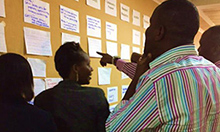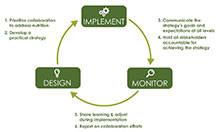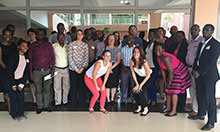
Links in the CHAIN
If you don’t know where you’re going, no road will get you there.
-Jannet Opio, Chief of Party for Society for Health/Rwanda
According to the 2015 Demographic and Health Survey, malnutrition rates in Rwanda have remained stubbornly high, with stunting documented at 41 and 49 percent in some rural, impoverished households. USAID | Rwanda wanted to apply a multi-sectoral approach to change this situation through its Community Health and Improved Nutrition (CHAIN) project. The project implements more than a dozen activities with local and international organizations to improve the use of key health services and products available to Rwandans. CHAIN is Rwanda’s means of implementing the USAID Multi-Sectoral Nutrition Strategy (2014-2025), which outlines how different nutrition-specific and nutrition-sensitive interventions can improve nutrition.
For these interventions to achieve their intended impact, partners must plan and implement their work collaboratively, which can be a challenge given the differences in training and perspectives when working across sectors. USAID | Rwanda recognized this challenge and invited USAID’s multi-sectoral nutrition project, SPRING, to facilitate an integrated work plan for fiscal year (FY) 2017.
Setting the Stage
SPRING worked with USAID | Rwanda to develop collaboration goals among CHAIN partners and prepared an analysis of the 11 partners’ existing work and monitoring and evaluation (M&E) plans. SPRING worked with the partners to map each of their interventions to the CHAIN Results Framework, complementing an existing map to help partners visualize opportunities for collaboration.
Using these tools, the partners developed an integrated work plan composed of 19 joint activities, spanning all of Rwanda’s geographic districts and multiple technical areas. Partners realized the benefit of thinking through activities together from the start. “[The workshop where these steps were taken] was one of the more useful and clear events I've been to since coming to Rwanda six months ago,” said one participant. “I've heard similar feedback from the other implementing partners. They have clarity now on what CHAIN is and feel like they have a shared purpose.”
Lessons on Collaboration
As part of implementing the joint work plan, the CHAIN partners agreed to participate in quarterly surveys focusing on the fruits—as well as the burdens—of their collaboration. These surveys have helped the USAID | Rwanda team identify and respond to potential pitfalls as they arise.
From Talk to Action
In year two, CHAIN partnerships resulted in—
- joint trainings of 70% of all Community Hygiene Club leaders in one district
- a joint WASH campaign that reached more than 4,600 individuals
- expanded reach of nutrient rich value chains – more than 31,000 farmers grew orange-fleshed sweet potato—almost 19,000 more than initially targeted!
- support to Government of Rwanda (GOR) emergency requests after insufficient rainfall, including targeted distribution of drought-resistant plant varieties in 15 affected districts.
For example, one survey revealed that although the CHAIN work planning was conducted in Kigali with management staff, implementation happens in the field, where buy-in is not automatic. As a result, USAID worked with the partners to develop CHAIN coordination platforms in each district, building them within existing Government of Rwanda coordination bodies. These platforms will help implementers at the field level plan, implement, and monitor CHAIN’s work.
As implementation of joint activities began, questions arose about who should “get credit” for certain results and what type of data quality assurance partners can expect from one another. USAID recognized the need for the partners to have joint monitoring tools and supported efforts to develop an M&E framework to accompany the FY 2018 Integrated Work Plan.
Looking Ahead
Through CHAIN, USAID | Rwanda and SPRING have seen what well-planned coordination and collaboration among development partners can achieve. Lessons learned on designing joint work plans and promoting collaboration at both national and field levels will be important for USAID | Rwanda, other USAID Missions, and implementing partners working multi-sectorally to address malnutrition in a holistic way. SPRING is documenting this work to share learning aimed at meeting the agency’s Multi-Sectoral Nutrition Strategy’s objectives. You can learn more on the SPRING website here.


